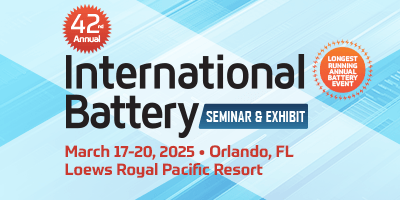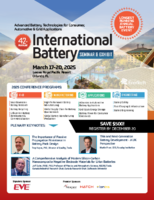Cambridge EnerTechによる
Battery Engineering
バッテリーエンジニアリング
Optimizing Cell and Pack Design through Engineering and AI
エンジニアリングとAIによるセル・パック設計の最適化
2025年3月19日 - 20日
バッテリー技術が進歩するにつれ、アクティブセル材料を最大限に活用する、綿密に設計されたバッテリーシステムの必要性が高まっています。安全性、信頼性、耐久性を優先して、安定したセル性能を確保し、製品にシームレスに組み込むパックを開発することが不可欠です。非アクティブコンポーネントの選択を含むセルの設計は、バッテリーの性能と信頼性に重要な役割を果たします。バッテリーパックの設計と統合は、セルの化学組成に関係なく、熱、機械、電気エンジニアリングの課題を提示します。アプリケーションのデューティサイクルに合わせて調整された、最適なセル・パック設計を実現するには、エネルギーや電力容量、製造可能性、乱用耐性、熱特性、コストの検討事項のバランスを慎重に考慮する必要があります。「バッテリーエンジニアリング」会議では、これらのトピックに加え、AIがバッテリー性能の向上にどのように役立つかについても取り上げます。
3月19日(水)
6:50 amRegistration Open
1:00 pmNetworking Luncheon
2:15 pmDessert Break in the Exhibit Hall with Poster Viewing
MATERIALS DESIGN
材料設計
Engineering of Solid-State Sulfide Electrolytes, Other Materials, and the Prototyping of All-SSB
 Lane Crofton, R&D Research Engineer, R&D Aerospace Defense & Performance ADP, SAFT America
Lane Crofton, R&D Research Engineer, R&D Aerospace Defense & Performance ADP, SAFT America
Solid-state batteries provide an excellent opportunity for innovation, thanks to their ability to combine higher energy density, greater power, and increased safety, but require new materials and processes. This report will focus on Saft’s position in the technological development of all-solid-state batteries (ASSB) and our progress in working with sulfide electrolytes. The topics of discussion will include screening for sulfide and silicon materials, creation of protective layers, as well as areas of growth for prototype development.
Computation Design for Materials
 Chen Ling, PhD, Principal Scientist, Toyota Research Institute of North America
Chen Ling, PhD, Principal Scientist, Toyota Research Institute of North America
Lethargic oxygen evolution reaction (OER) hinders proton exchange membrane water electrolyzer adoption for green hydrogen production. While iridium- and ruthenium-based catalysts are prevalent, this study proposes a high-throughput screening approach, predicting 61 potential acid OER candidates from 6912 pyrochlore compounds, including promising p-block metal dopants. These findings highlight pyrochlore compounds as versatile materials for various applications.
4:20 pmRefreshment Break in the Exhibit Hall with Poster Viewing
BATTERY SYSTEMS AND TESTING
バッテリーシステムと試験
Lithium Battery Packs and Battery Management Systems for Racing Applications
 Derek Barger, Chief of Electronics, Engineering, Doroni Aerospace
Derek Barger, Chief of Electronics, Engineering, Doroni Aerospace
We will examine custom battery packs engineered for racing vehicles and explore how these innovations are being adapted for use in the aerospace industry, particularly in electric vehicle vertical takeoff and landing (eVTOL) aircraft. This discussion will cover their implications for safety, battery pack design, and the circular battery pack recycling system.
Fast Track to Superior Automotive Batteries: Virtual System Validation and AI-Driven Testing
 Gerald Sammer, PhD, Principal Business Development Manager, AVL List GmbH
Gerald Sammer, PhD, Principal Business Development Manager, AVL List GmbH
The proposal highlights the use of advanced AI and virtual testing methods to enhance battery performance and quality for automotive applications in much shorter time. By integrating state-of-the-art simulation tools and virtualization solutions, this approach allows for rapid, cost-effective development and optimization of battery systems. Utilizing predictive modeling and iterative design optimization, engineers can explore diverse scenarios, accelerating the development process and significantly improving quality and cycle-life of Li-ion batteries.
Big Data for the Diagnosis and Prognosis of Deployed Battery Systems
 Matthieu Dubarry, PhD, Assistant Researcher, Battery Testing & Evaluation & Modeling, University of Hawaii
Matthieu Dubarry, PhD, Assistant Researcher, Battery Testing & Evaluation & Modeling, University of Hawaii
The diagnosis and prognosis of deployed batteries is complex because the cells might never experience controlled conditions during operation as both the charge and discharge duty cycles could be sporadic. To circumvent this issue new methodologies must be implemented and thoroughly validated. This work presents a new methodology for diagnosis that used real observed solar irradiance, modeled clear sky irradiance, a load usage model, and synthetically-generated battery data from a battery digital twin to diagnose the degradation of commercial Li-ion batteries connected to photovoltaic systems.
6:30 pmClose of Day
3月20日(火)
8:00 amRegistration and Morning Coffee
THERMAL RUNAWAY
熱暴走
Examination of Passive and Active Approaches to Mitigation of Thermal Runaway Propagation
 Stanislav I. Stoliarov, PhD, Professor, Fire Protection Engineering, University of Maryland
Stanislav I. Stoliarov, PhD, Professor, Fire Protection Engineering, University of Maryland
In the energy storage systems containing multiple lithium-ion cells, thermal runaway may propagate from cell to cell and grow into a large fire or an explosion. Several module-level migration strategies have been tested in this work to determine their effectiveness. These strategies included introduction of air gaps and solid physical barriers between cell clusters as well as injection of fire suppression agents such as Novec 1230 and water mist. Certain barriers were found to be effective in slowing down the thermal runaway propagation. The suppression agents were found to be effective only at the concentrations and application rates significantly higher than those recommended for traditional fires
9:00 amBattery Booth Crawl with Bagels in the Exhibit Hall with Last Chance for Poster Viewing
AI BATTERY MANAGEMENT SYSTEMS
AIバッテリー管理システム
 Accelerating the battery design process: A physics-based modeling approach.
Accelerating the battery design process: A physics-based modeling approach.
 Johan Sundqvist, VP Sales, Sales, COMSOL Inc
Johan Sundqvist, VP Sales, Sales, COMSOL Inc
Designing high-performance, durable, and safe batteries requires a detailed understanding of battery technology and the underlying physical processes. The physics-based modeling approach in COMSOL helps designers to create accurate simulations of batteries, thus reducing the need for time-consuming and expensive experiments. The COMSOL software provides modeling solutions of batteries ranging from simulating micro-structures within the battery’s porous electrode to the battery pack scale. In this presentation, we will explore various aspects of electrochemical modeling for battery cells, upscaling to system-level modeling and incorporating thermal management solutions for battery packs.
10:00 amAttendee Transition to Booth Crawl in Exhibit Hall
PREDICTING BATTERY DEGREDATION
バッテリー劣化の予測
A Method for Estimating the Useful Lifetime of Lithium-ion Battery
 Cher-Ming Tan, PhD, Director, Center for Reliability Sciences & Technologies, Chang Gung University
Cher-Ming Tan, PhD, Director, Center for Reliability Sciences & Technologies, Chang Gung University
Current method of useful life is based on the SoH monitoring of LiB and perform various methods to estimate from the trend of SoH degradation, and usually these LiB cells are already connected. This talk presents a method where the estimation is done on the first charge-discharge cycle of LiB cell, allowing for good selection of cells for pack building. This method is verified experimentally using commerical LiB cells of different rating from different suppliers. It can also help to spot used cells that may be sold as fresh cell. It can also apply to connected cells during their operations.
Predicting Rapid Degradation Onset in Lithium-ion Batteries during Real-Time Operation Using Machine Learning
 Vikas Tomar, PhD, Faculty Lead, Innovation and Commercialization, School of Aeronautics and Astronautics, Purdue
Vikas Tomar, PhD, Faculty Lead, Innovation and Commercialization, School of Aeronautics and Astronautics, Purdue
This talk presents low data machine learning models for capacity degradation trajectory and EOL of commercial lithium-ion batteries (LIBs) using the data from the initial historical cycles, employing a recently developed machine learning approach based on a capacity degradation network (CD-Net). Additionally, the machine learning models are employed to predict the knee point in the degradation curve showing applicability to accident scenario. Finally, data is shown in real world operations.

Can We Trust AI for Battery Design and Testing?
 Richard Ahlfeld, CEO, Monolith AI
Richard Ahlfeld, CEO, Monolith AI
AI is transforming industries, offering powerful new tools but also raising debates around regulation and trust. In engineering, AI can streamline processes, enhance innovation, and reduce costs-but is it always appropriate?
In this talk, Richard Ahlfeld explores how AI and machine learning can drive faster time-to-market, improved design, and cost savings, with a focus on battery technology. Through practical examples, he’ll demonstrate AI’s impact on optimising battery performance, energy storage, and predictive maintenance, and discuss future opportunities and challenges for AI in engineering.
12:15 pmEnjoy Lunch on Your Own
CONTROLS & MODELLING
制御とモデリング
Model-Based Control and Machine Learning for Lithium-ion and Lithium-Sulfur Batteries
 Hosam K. Fathy, PhD, Mechanical Engineering, University of Maryland College Park
Hosam K. Fathy, PhD, Mechanical Engineering, University of Maryland College Park
This talk will provide a high-level exploration of some of the key challenges and opportunities in the model-based control of both lithium-ion and lithium-sulfur batteries, including both solid and liquid electrolyte Li-S batteries. Much of the talk will focus on emerging opportunities for test trajectory optimization and machine learning for both battery types, with a focus on Li-S batteries.
Estimating Parameters of Physics-Based Model of Lithium-Metal Battery Cells Using EIS
 Gregory L. Plett, PhD, Professor, Electrical & Computer Engineering, University of Colorado, Colorado Springs
Gregory L. Plett, PhD, Professor, Electrical & Computer Engineering, University of Colorado, Colorado Springs
Lithium-metal batteries hold promise for heavy-duty transportation due to their high energy density, but before they can be adopted, battery-management systems (BMS) must be developed to monitor and control their operation. This talk introduces a method to parameterize a physics-based model of these cells for BMS application that uses simple tests performed on electrochemical-impedance-spectroscopy (EIS) equipment.
A Comparative Review of Simplified Battery Models Used for Advanced Controls
 Scott Trimboli, PhD, Professor, Electrical & Computer Engineering, University of Colorado, Colorado Springs
Scott Trimboli, PhD, Professor, Electrical & Computer Engineering, University of Colorado, Colorado Springs
State-of-the-art BMS rely on accurate battery models and specialized algorithms to obtain useful estimates of the battery state in order to ensure proper performance and safe operation. Most practical models are simplifications, and thus must trade off high accuracy for computational efficiency. This talk examines the implications of using various simplified models in the performance of key BMS tasks.
Understanding, Modeling, Validating, and Predicting Lithium-ion Battery Degradation
 Gregory J. Offer, PhD, Professor in Electrochemical Engineering, Imperial College London
Gregory J. Offer, PhD, Professor in Electrochemical Engineering, Imperial College London
This presentation covers understanding lithium-ion battery degradation, how to model it, and how close those models are getting to usefully predict lifetime. We will describe our efforts to model lithium plating, SEI layer growth, positive electrode (cathode) decomposition, unequal degradation in silicon carbon composite electrodes, particle cracking, electrolyte consumption and cell dry-out, and how multiple degradation mechanisms are coupled with each other and contribute towards accelerated degradation (the knee point/cliff-edge/etc).
3:15 pmTransition to Closing Plenary Panel
CLOSING PLENARY PANEL DISCUSSION
プレナリーパネルディスカッションの閉会
The Global Battery Industry Landscape: Opportunities & Illusions
Christina Lampe-Onnerud, PhD, Founder and CEO, Cadenza Innovation
As the global battery industry experiences supercharged growth amidst shifting political dynamics, it faces both immense opportunities and significant challenges. This international panel of experts, spanning critical sectors such as investment, supply chain, cell design, manufacturing and deployment, will share their insights on the industry's future. They will discuss growth prospects, key challenges, and achievable milestones in the near and long term.
4:30 pmClose of Conference
* 不測の事態により、事前の予告なしにプログラムが変更される場合があります。
アジェンダ・講演者・スポンサー更新





 Talk Title to be Announced
Talk Title to be Announced
 Talk Title to be Announced
Talk Title to be Announced

 Talk Title to be Announced
Talk Title to be Announced









 Next-Generation Battery Research
Next-Generation Battery Research High-Performance Battery Manufacturing
High-Performance Battery Manufacturing Advances in Automotive Battery Applications
Advances in Automotive Battery Applications Battery Safety
Battery Safety
